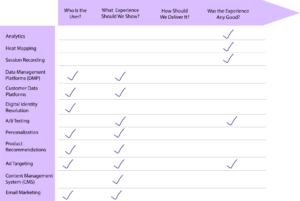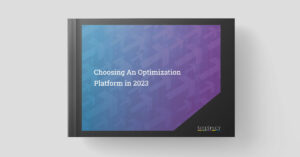Part 6/6: Are the Tools in Your Ecosystem Helping or Hurting?
By Justin Bougher
March 31, 2020
Share
We’ve made it to the final blog in my series, “5 Questions You Need to Answer to Optimize an Experience.” To recap, so far we’ve covered, an overview of my approach to optimization, and I walked through ways to answer the questions:
- Who is the user?
- What experience should you show a user?
- How should you deliver that experience?
- Was the User’s Experience Any Good?
Once you have an understanding of how to evaluate the user experience, it’s crucial to also evaluate the tools in your ecosystem that touch that experience. Often, and for many reasons, organizations stick with the tools they have and try to make the best of them. But, to fully optimize the user experience, the final step is to look at the tools in your ecosystem and determine whether they are underutilized, providing conflicting data, not achieving your goals, or performing as you’d like them to. Here is how I suggest evaluating your technology ecosystem.
Which Tools Answer Which Questions?
Many organizations find that they have multiple tools to answer different parts of the same question — for example, a basic analytics tool, plus a heat mapping tool. Or, multiple teams may be using different tools to answer the same question, which produces silos of redundant information. For example, RUM performance data may be available only to your IT team to measure performance, while your Marketing team measures performance with an entirely different tool. Below are some common types of tools and the questions that they answer.

Are those tools talking to each other?
Most companies have multiple tools to address each question. So, it’s important to make sure that those tools communicate with each other and across your ecosystem. Typically, this is done through “product integrations,” which requires each tool in your ecosystem be integrated with all others — or with at least one centralized location. This can work, but presents a couple of limitations. First, it necessitates additional time and effort to configure the integration, and limits your ability to analyze and react in real time.
One alternative is to leverage a more distributed data layer which communicates information about the user and the experience. A data layer is a hidden object in the page that usually describes something about the user, the experience, a product, or any piece of relevant contextual information. Other applications in your ecosystem can see this object to inform them what to do. It’s important for your solutions to have the flexibility to integrate through multiple options including APIs, cookies, and data layers to future-proof the communication as technology changes.
What other parts of the organization should you be talking to?
Most teams in your organization either own or play a significant role in offering users a great experience. Part of evaluating your ecosystem should involve talking to each team invested in the user experience to understand how they answer each of the above questions. See if their approaches align with yours… or not.
Some of the teams to check in with are:
- Marketing: Most outbound marketing teams have a defined set of audiences to drive social, email, and print marketing. Are their audiences the same as yours? What types of experiences are they providing? Do they align with your audiences and segments?
- Merchants: In the case of ecommerce companies, merchants drive their own set of promotions and offers. Some may be automated through product recommendations while others will be a part of conversion campaigns. Check to see if there are any conflicts with the users and types of experiences. Also understand what products they are using to deliver promotions on your site? How are they using CMS? What other 3rd-party tools are used? Are they using JavaScript tags?
- UX: Every UX team will have a defined group of personas and an understanding of the user experience for each group. Does this match what you’re learning from other teams? If, not, where do they differ?
- Product Managers and Dev teams: If you don’t have one platform for both client-side and server-side optimization and analytics, what tools are product and development teams using to test releases? If not segmented properly, these different experiences may interfere with optimization campaigns across the organization.
- IT: IT teams typically have a lot of information regarding site performance. This then provides insights into user experience. Real User Monitoring (RUM) data can also allow you to segment performance information to match your audiences. Keeping performance information for each segment is critical to validating if you are successfully offering a great experience. The problem may not be what you are delivering but how you are delivering it.
Optimization Across the Organization
As you can see from this series, optimizing a user experience entails a lot more than measuring conversions. To do it right, you have to dive deep into every component of the experience, coordinate across teams, and consider factors you may not have considered previously. But, at the end of the process, you’ll be able to say that you are truly invested in optimization.
If you have any questions, or would like to continue the conversation, please don’t hesitate to leave a comment below or reach me directly at jbougher@sitespect.com.
To learn more about SiteSpect, visit our website.
Share
Suggested Posts
Subscribe to our blog:





